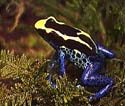


A medicine man who makes his home in the tropical rainforest of the Amazon
listens intently as huge trees crash to the forest's floor in the distance. He has been
told that machines are being used to build roads into the forest and that many trees are
being taken away on trucks. He wonders how long the plants and animals that are the
sources for the potions he makes to heal and protect the members of this tribe will
remain. As he looks at the ground, he notices a dart frog that provides the poisonous
venom for the points of the darts and arrows the tribesmen use. By rubbing the points of
the dart and arrows across the back of one of these frogs, hunters ensure a swift death to
their prey. Left: Dendrobates
Tinctorius, a colorful species of poison dart frog, is found in the humid forests of
French Guiana, Surinam, and Guyana. Photo: Chris
Valdez, courtesy of the Oglebay Parks Good Zoo
 At the same time, a
medical researcher in the United States is engaged in a study to identify the medicinal
properties of the dart frog's poison. Other researchers throughout the world are studying
exotic vegetation that is found only in the tropical rainforests. One ethnobotanist has
cataloged over 200 of these exotic plants along with their medical remedies. Soothing
burns, easing childbirth, and healing infections are among some of the beneficial uses
derived from these plants. Right: Blowguns such as the one held by this Yagua tribesman have been used as an
effective weapon in the Amazon for centuries. Photo: Larry Cartmill
At the same time, a
medical researcher in the United States is engaged in a study to identify the medicinal
properties of the dart frog's poison. Other researchers throughout the world are studying
exotic vegetation that is found only in the tropical rainforests. One ethnobotanist has
cataloged over 200 of these exotic plants along with their medical remedies. Soothing
burns, easing childbirth, and healing infections are among some of the beneficial uses
derived from these plants. Right: Blowguns such as the one held by this Yagua tribesman have been used as an
effective weapon in the Amazon for centuries. Photo: Larry Cartmill
Environmentalists are attempting to measure the impact of the rainforest on the entire biosphere. Much of their data indicates a significant and wide ranging influence, which leads to concerns over the consequences of deforestation. Many argue that the destruction of the rainforest should be stopped.
On the other hand, developers and builders as well as exporters and some South American governmental agencies maintain that the economic growth and prosperity of the region and its people require the continued "development" of the rainforest. Hewed trees are providing materials for construction and exportable products. Cleared land is providing space for people to enjoy an improved standard of living.
Is there a problem? Is the Amazon, the richest area of biodiversity in the world, threatened by human beings? Your group has been contacted by the Global Research Information Network (G.R.I.N.), an impartial panel composed of scientists and representatives from government, business, and industry. They want you to analyze the situation and make recommendations. They aren't sure what position to take concerning poison dart frogs and other species in the Amazon.
|
[ References ] [ PBL Model ] [ Home ] [ Teacher Pages ] [ Modules & Activities ] |
Page created by Chris Kreger
Maintained by ETE Team
Last updated November 10, 2004
Some images © 2004 www.clipart.com
Privacy Statement and Copyright © 1997-2004 by Wheeling Jesuit University/NASA-supported Classroom of the Future. All rights reserved.
Center for Educational Technologies, Circuit Board/Apple graphic logo, and COTF Classroom of the Future logo are registered trademarks of Wheeling Jesuit University.